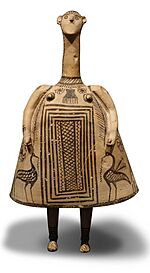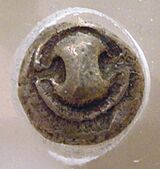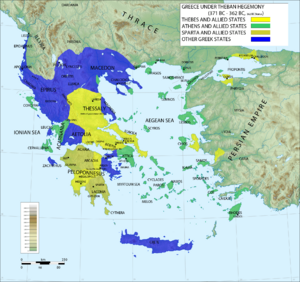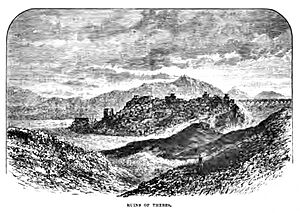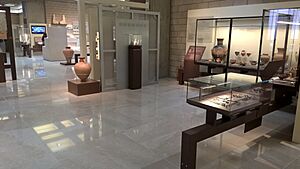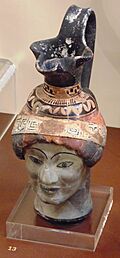Thebes, Greece facts for kids
Quick facts for kids
Thebes
Θήβα
|
|
|---|---|
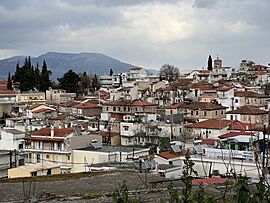
View of Thebes.
|
|
| Country | Greece |
| Administrative region | Central Greece |
| Regional unit | Boeotia |
| Area | |
| • Municipality | 830.112 km2 (320.508 sq mi) |
| • Municipal unit | 321.015 km2 (123.945 sq mi) |
| Elevation | 215 m (705 ft) |
| Population | |
| • Municipality | 32,410 |
| • Municipality density | 39.043/km2 (101.121/sq mi) |
| • Municipal unit | 23,930 |
| • Municipal unit density | 74.545/km2 (193.07/sq mi) |
| Demonym(s) | Theban |
| Community | |
| • Population | 21,530 ({{{population_as_of}}}) |
| • Area (km2) | 143.889 |
| Time zone | UTC+2 (EET) |
| • Summer (DST) | UTC+3 (EEST) |
| Postal code |
32200
|
| Area code(s) | 22620 |
Thebes (pronounced THEEBZ) is a city in Boeotia, Central Greece. It is one of the oldest cities in the world where people have lived continuously. Thebes is the biggest city in Boeotia. It is a very important center for the area, along with Livadeia and Tanagra.
Thebes played a big part in many Greek myths. It was the setting for stories about heroes and gods like Cadmus, Oedipus, Dionysus, and Heracles. One myth says the city was founded by Agenor. This is why Thebans were sometimes called "Agenorids." Digs in Thebes have found signs of a Mycenaean settlement. They also found clay tablets with Linear B writing. This shows how important Thebes was during the Bronze Age.
In ancient times, Thebes was the largest city in the Boeotia region. It led the Boeotian confederacy, which was a group of cities working together. Thebes was a major rival of ancient Athens. It even sided with the Persians during the invasion in 480 BC. Later, Theban forces led by Epaminondas defeated Sparta at the Battle of Leuctra in 371 BC. The Sacred Band of Thebes, an elite military unit, was key to this victory.
However, Philip II of Macedon rose to power. He defeated Thebes and Athens at the Battle of Chaeronea in 338 BC. Thebes was a strong force in Greek history until Alexander the Great destroyed it in 335 BC. At that time, Thebes was the most powerful city-state in Greece. During the Byzantine period, Thebes was famous for making beautiful silks.
Today, the modern city has an archaeological museum. You can also see the remains of the Cadmea, which was an ancient fortress. The Holy Church of Luke the Evangelist is also in Thebes. It is believed to hold Luke's tomb and relics. Modern Thebes is the largest town in the Boeotia region.
Contents
The City of Thebes Today
In 2011, a change called the Kallikratis reform happened in Greece. Because of this, Thebes joined with three other towns: Plataies, Thisvi, and Vagia. They formed a larger municipality that kept the name Thebes. The other three towns became parts of this bigger municipality.
A Look at Thebes' Past
Early History of Thebes
Archaeological digs in Thebes have found ancient graves from Mycenaean times. These graves contained weapons, ivory, and clay tablets. The tablets had writing in a script called Linear B. Ancient names for Thebes found on these tablets include "Tʰēgʷai̮s" (meaning "at Thebes") and "Tʰēgʷasde" (meaning "to Thebes").
Thebes was one of the first Greek communities to build strong walls around its city. It was important in ancient times because of its military strength. Some historians believe that a statue base from an ancient Egyptian kingdom mentions a name similar to Thebes. This shows that Thebes was known even in distant lands.
Ancient Thebes: A Powerful City
Thebes was often called "Seven-Gated Thebes" in ancient writings. This was to tell it apart from "Hundred-Gated Thebes" in Egypt.
In the late 500s BC, Thebes first had problems with the Athenians. Athens helped a small village stay independent from Thebes. Thebes did not like Athens. This might explain why Thebes seemed to support the Persian invasion of Greece in 480–479 BC. Even though some Theban soldiers fought bravely at Thermopylae, Thebes later joined King Xerxes I of Persia and fought for him at the Battle of Plataea.
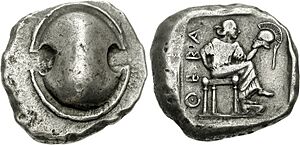
After the Greeks won the war, they punished Thebes. They took away its leadership of the Boeotian League. But in 457 BC, Sparta changed its mind. Sparta wanted a strong city to balance Athens' power in central Greece. So, Sparta helped Thebes become powerful again in Boeotia. The strong fortress of Cadmea in Thebes helped it resist Athens.
During the Peloponnesian War, Thebes was a strong ally of Sparta. Thebans were angry that Athens supported smaller towns against them. In 424 BC, Theban forces defeated an Athenian army at the Battle of Delium. This showed their growing military strength.

After Athens fell, Thebes broke its alliance with Sparta. Thebans felt Sparta was trying to stop them from expanding. In 403 BC, Thebes secretly helped Athens restore its democracy. This was to create a balance against Sparta. Later, Thebes led a group of cities against Sparta. At the Battle of Haliartus (395 BC) and the Battle of Coronea (394 BC), Thebes proved its military skill against the Spartans.
Theban power grew even more. The Theban army was trained and led by great generals like Epaminondas and Pelopidas. They formed an elite unit called the Sacred Band of Thebes. This unit was known for its bravery and skill in battle. In 371 BC, Thebes won a huge victory over Sparta at Leuctra. This battle changed everything. Thebans were seen as heroes who helped the oppressed. They went into Peloponnesus and greatly weakened Sparta's power. They even freed many helot slaves, who were important to Sparta's economy.
The Decline and Destruction of Thebes
Thebes' time as the most powerful city did not last long. The cities it had helped did not want to be controlled by Thebes forever. Thebes also started to have problems with Athens again. When Epaminondas died at the Battle of Mantinea (362 BC), Thebes became a less important power.
In the Third Sacred War (356–346 BC), Thebes lost its power in central Greece. Thebes asked Philip II of Macedon to help them defeat their enemies. This brought Philip's power too close to Thebes. In 338 BC, Thebes joined Athens to try and stop Philip's advance. But they lost the important Battle of Chaeronea. This ended their hope of controlling Greece.
Philip took away Thebes' control over Boeotia. But in 335 BC, Thebes revolted against Philip's son, Alexander the Great. Alexander was campaigning in the north at the time. When he returned, Alexander and his Greek allies punished Thebes severely. They destroyed the city, except for the house of the poet Pindar and the temples. The people of Thebes were sold into slavery. This harsh act made Athens submit to Alexander.
Thebes Rises Again
After Alexander the Great died in 323 BC, Thebes was rebuilt in 315 BC. This was done by Cassander, one of Alexander's generals who ruled Greece. Cassander wanted to fix what Alexander had done. This act of kindness earned him a lot of support across Greece. Many Greek cities helped rebuild Thebes. For example, the Athenians helped rebuild much of Thebes' wall.
Even after being rebuilt, Thebes never became as powerful as it once was. After Cassander died, there was a power struggle in Greece. Thebes was attacked by Demetrius Poliorcetes in 293 BC and again in 292 BC. The city fought hard, but Demetrius captured it again. However, he treated the city kindly despite its resistance. Thebes regained its freedom in 287 BC.
Thebes Under Roman and Byzantine Rule
After 146 BC, Thebes came under Roman rule. In 27 BC, it became part of the new Roman Province of Achaia. Later, Thebes became part of the Eastern Roman Empire. In the early Byzantine period, it was a safe place from invaders. In the late 600s, Thebes became the capital of a region called Hellas. The Holy church of Luke the Evangelist was built around the 900s to honor the saint's tomb.
From the 900s, Thebes became a major center for the silk trade. Its silk workshops grew, helped by imports of soaps and dyes. By the mid-1100s, Thebes was the biggest producer of silks in the entire Byzantine empire. It even made more silk than Constantinople, the capital. The women of Thebes were famous for their weaving skills. Theban silk was highly valued for its quality.
A traveler named Benjamin of Tudela visited Thebes around 1161 or 1162. He reported that Thebes was a busy city. It was an important market and a center for silk textiles. He estimated that Thebes had between 20,000 and 30,000 people. It also had a large Jewish community of 2,000 people.
Even though Thebes was heavily looted by the Normans in 1146, it quickly recovered. It continued to grow until the Fourth Crusade captured it in 1205.
Thebes in Later Times
Because of its wealth, Thebes was chosen as the capital by the Frankish de la Roche family. They later moved the capital to Athens. From 1240, the Saint Omer family also controlled the city. A beautiful castle was built on the Cadmea by Nicholas II of Saint Omer. In 1311, the Catalan Company captured Thebes and used it as their capital for a short time.
In 1379, the Navarrese Company took the city with help from the Latin Archbishop of Thebes. Latin rule in Thebes lasted until 1458. That's when the Ottomans captured it. The Ottomans called Thebes "İstefe." They ruled it until the Greek War of Independence in 1821. There was a short time between 1687 and 1699 when the Venetians controlled it.
In modern Greece, Thebes was the capital of the Boeotia region until the late 1800s. Then Livadeia became the capital.
Today, Thebes is a busy market town. It is known for its many products. In the past, it had a lot of farming and some factories. But in the late 1980s and 1990s, most factories moved closer to Athens. Tourism in Thebes is not very high. This is because there are more famous places nearby, like Athens. However, there are many interesting ancient sites in and around Thebes, like the battlefield where the Battle of Plataea took place.
Thebes in Greek Myths
The early history of Thebes is full of amazing Greek legends. These stories are as rich as the myths of Troy. They greatly influenced ancient Greek literature.
The Greeks believed that Cadmus founded Thebes. Cadmus was a Phoenician king from Tyre. He was the brother of Queen Europa. Cadmus was famous for teaching the Phoenician alphabet. He also built the Acropolis of Thebes, which was named the Cadmeia after him. This Cadmeia was a very important center for learning and culture.
Thebes' Location and Environment
Geography
Thebes is located on a flat plain. To the north is Lake Yliki (ancient Hylica). To the south are the Cithaeron mountains. These mountains separate Boeotia from Attica. The city is about 215 meters (705 feet) above mean sea level. It is about 50 kilometers (31 miles) northwest of Athens. It is also about 100 kilometers (62 miles) southeast of Lamia. The A1 motorway and the Athens–Thessaloniki railway connect Thebes to Athens and northern Greece.
Climate
Thebes has a hot-summer Mediterranean climate. This means it has hot, dry summers and cool, wet winters. In winter, Thebes sometimes gets snow from the Aegean Sea. Snow can be quite deep at times. Because Thebes is inland, it can also get very cold. The lowest temperature recorded was -7.9°C (17.8°F) in January 2017. In summer, Thebes can get very hot during heat waves. The highest temperature recorded was 44.5°C (112.1°F) in August 2021.
| Climate data for Aliartos, Thebes (180 m, 1967–2001) | |||||||||||||
|---|---|---|---|---|---|---|---|---|---|---|---|---|---|
| Month | Jan | Feb | Mar | Apr | May | Jun | Jul | Aug | Sep | Oct | Nov | Dec | Year |
| Mean daily maximum °C (°F) | 11.5 (52.7) |
12.9 (55.2) |
15.6 (60.1) |
20.4 (68.7) |
25.8 (78.4) |
30.9 (87.6) |
32.4 (90.3) |
31.9 (89.4) |
28.6 (83.5) |
22.5 (72.5) |
17.2 (63.0) |
13.1 (55.6) |
21.9 (71.4) |
| Daily mean °C (°F) | 7.1 (44.8) |
8.3 (46.9) |
10.7 (51.3) |
15.3 (59.5) |
20.7 (69.3) |
25.7 (78.3) |
27.3 (81.1) |
26.4 (79.5) |
22.6 (72.7) |
17.0 (62.6) |
12.2 (54.0) |
8.7 (47.7) |
16.8 (62.2) |
| Mean daily minimum °C (°F) | 2.9 (37.2) |
3.6 (38.5) |
5.0 (41.0) |
8.1 (46.6) |
12.2 (54.0) |
16.0 (60.8) |
17.9 (64.2) |
17.4 (63.3) |
14.5 (58.1) |
11.0 (51.8) |
7.2 (45.0) |
4.4 (39.9) |
10.0 (50.0) |
| Average precipitation mm (inches) | 77.3 (3.04) |
74.1 (2.92) |
63.8 (2.51) |
40.0 (1.57) |
28.8 (1.13) |
13.8 (0.54) |
6.1 (0.24) |
13.8 (0.54) |
17.4 (0.69) |
69.5 (2.74) |
74.1 (2.92) |
96.4 (3.80) |
575.1 (22.64) |
| Source: HNMS | |||||||||||||
Famous People from Thebes
From Ancient Times
- Pindar (around 518–443 BC), a famous poet.
- Pelopidas (around 420–365 BC), a general and leader who led a rebellion against Sparta. He commanded the Theban "Sacred Band" at the Battle of Leuctra.
- Epaminondas (around 418–362 BC), a general and leader who commanded Theban forces at the battles of Leuctra and Mantinea.
- Aristides of Thebes (4th century BC), a painter.
- Nicomachus of Thebes (4th century BC), a painter.
- Crates of Thebes (around 365 – around 285 BC), a Cynic philosopher.
- Luke the Evangelist (died 84 AD), believed to be buried here.
From Modern Times
- Theodoros Vryzakis (around 1814–1878), a painter.
- Archbishop Ieronymos II of Athens (born 1938), a religious leader.
- Haris Alexiou (born 1950), a popular singer.
Images for kids
-
A bust of Pindar
See also
 In Spanish: Tebas (Grecia) para niños
In Spanish: Tebas (Grecia) para niños





